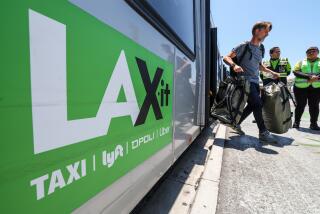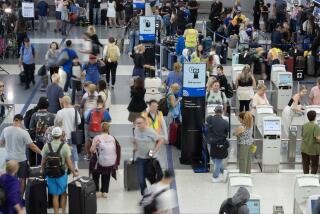The human factors in LAX safety
I cannot agree more with the argument in The Times’ Nov. 22 editorial, “What LAX really needs,” that improving safety should be the highest priority at Los Angeles International Airport. However, improving safety at LAX cannot simply be achieved, as The Times suggests, by “reconfiguring the north airfield, where parallel runways built for and earlier generation of aircraft are too close together for safety operations.” The root cause of LAX’s safety problems lies elsewhere.
Based on my research and teaching on aviation safety and runway incursions for the last 20 years at the University of Southern California, I have found that human factors are the most important contributor to runway incursions. In fact, according to the two most recent authoritative studies on the state of runway safety in the United States conducted by the Government Accountability Office, in which I was one of the 25 experts who participated, “the primary causes of incursions, according to experts we surveyed and some airport officials, are human factors issues, which can include miscommunication between air traffic controllers and pilots, a lack of situational awareness on the airfield by pilots, and performance and judgment errors by air traffic controllers and pilots.” During the fiscal year 2007, “pilot error” and “controller error” accounted for 85% of runway incursion causes.
According to the GAO, among 20 major U.S. airports that experienced the most runway incursions from fiscal year 2001 to August 2008, LAX has had the highest number of the two “most serious” categories of incursions (where one airplane must “take extreme action to narrowly avoid a collision”) and the second-highest number of other types of incursions, after Chicago O’Hare International Airport.
I would like to point out that the most notable causes of runway incursions include, in addition to airport geometry and design, poor visibility (because of fog, for example), air traffic controllers’ communication practices, air traffic controller staffing, workload and fatigue, deficient or inoperative ground radar systems, departure delay, duty time limitation and pressure on cockpit crews, cockpit crews’ inadequate situational awareness, and cultural and language differences among interacting parties.
There are strong indications that our air traffic controllers nationwide are increasingly suffering from fatigue. This critical issue prompted the National Transportation Safety Board to update its “Most Wanted List” of safety improvements and add “three safety recommendations on air traffic controller fatigue to the existing aviation issue area that addresses human fatigue.”
To improve LAX safety, we have to act now by seriously addressing human factors such as workload, staffing, equipment adequacy and fatigue issues at the airport’s air traffic control tower. We cannot wait for federal agencies to conduct another protracted study and come up with recommendations. As The Times correctly says, “We expect better from our leaders” in this case. L.A. Mayor Antonio Villaraigosa should appoint an independent blue-ribbon commission to help tackle these urgent problems.
Najmedin Meshkati, a professor at USC’s Viterbi School of Engineering, conducts research on human factors in aviation safety.
More to Read
A cure for the common opinion
Get thought-provoking perspectives with our weekly newsletter.
You may occasionally receive promotional content from the Los Angeles Times.










